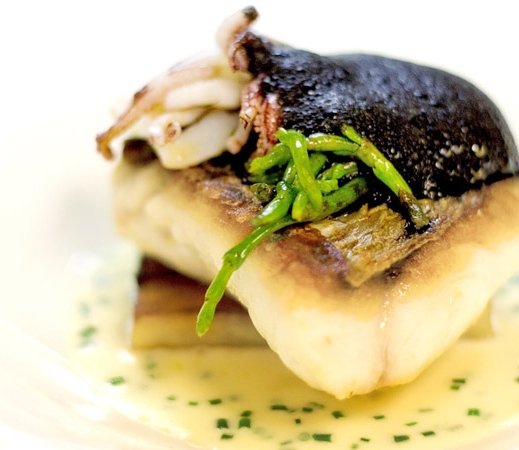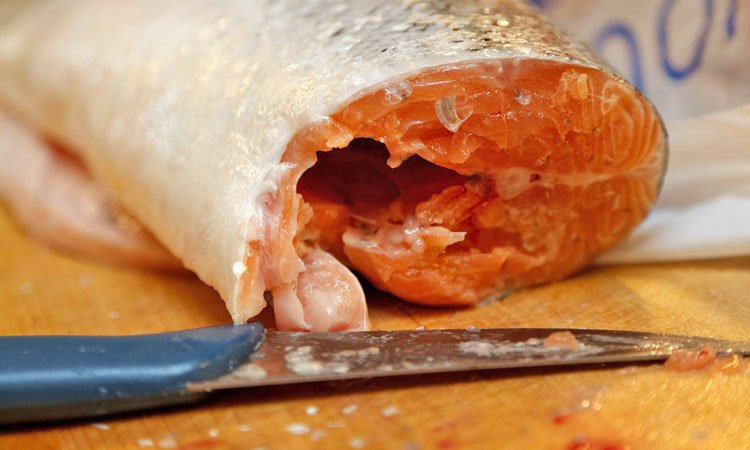New Zealand Glazed Snapper with Vanilla Saffron

Ingredients:
4 vine-ripened tomatoes
12 baby gourmet potatoes
4 medium fillets of fresh snapper
1 cup fresh arugula
For Vanilla Saffron Aioli
1 tablespoon white wine vinegar
1/2 teaspoon ground New Zealand or regular saffron
1 vanilla pod or 1 teaspoon of vanilla extract
1/2 teaspoon fine salt
1 egg yolk
6 oz. grape seed oil
For Lemon Caramel
1/2 cup sugar
2 tablespoons water
1/2 teaspoon salt
Juice of 1 lemon
Directions:
Place tomatoes on a tray of rock salt in the oven at 320° F and roast until skins begin to split.
Remove from oven and keep warm. Slice potatoes into thin slices and pan fry in olive oil with sea salt till golden and crispy.
Other Cuisine Related Articles
Cooking Grains

All grains, with the exception of rice, and the various grain meals, require prolonged cooking with gentle and continuous heat, in order to so disintegrate their tissues and change their starch into dextrine as to render them easy of digestion. Even the so-called “steam-cooked” grains, advertised to be ready for use in five or ten minutes, require a much longer cooking to properly fit them for digestion. These so-called quickly prepared grains are simply steamed before grinding, which has the effect to destroy any low organisms contained in the grain. They are then crushed and shredded. Bicarbonate of soda and lime is added to help dissolve the albuminoids, and sometimes diastase to aid the conversion of the starch into sugar; but there is nothing in this preparatory process that so alters the chemical nature of the grain as to make it possible to cook it ready for easy digestion in five or ten minutes. An insufficiently cooked grain, although it may be palatable, is not in a condition to be readily acted upon by the digestive fluids, and is in consequence left undigested to act as a mechanical irritant.
Water is the liquid usually employed for cooking grains, but many of them are richer and finer flavored when milk is mixed with the water, one part to two of water. Especially is this true of rice, hominy, and farina. When water is used, soft water is preferable to hard. No salt is necessary, but if used at all, it is generally added to the water before stirring in the grain or meal.
The quantity of liquid required varies with the different grains, the manner in which they are milled, the method by which they are cooked, and the consistency desired for the cooked grain, more liquid being required for a porridge than for a mush.
All grains should be carefully looked over before being put to cook.
In the cooking of grains, the following points should be observed:
1. Measure both liquid and grain accurately with the same utensil, or with two of equal size.
2. Have the water boiling when the grain is introduced, but do not allow it to boil for a long time previous, until it is considerably evaporated, as that will change the proportion of water and grain sufficiently to alter the consistency of the mush when cooked. Introduce the grain slowly, so as not to stop the sinking to the bottom, and the whole becomes thickened.
3. Stir the grain continuously until it has set, but not at all afterward. Grains are much more appetizing if, while properly softened, they can still be made to retain their original form. Stirring renders the preparation pasty, and destroys its appearance.
In the preparation of all mushes with meal or flour, it is a good plan to make the material into a batter with a portion of the liquid retained from the quantity given, before introducing it into the boiling water. This prevents the tendency to cook in lumps, so frequent when dry meal is scattered into boiling liquid. Care must be taken, however, to add the moistened portion very slowly, stirring vigorously meantime, so that the boiling will not be checked. Use warm water for moistening. The other directions given for the whole or broken grains are applicable to the ground products.
Place the grain, when sufficiently cooked, in the refrigerator or in some place where it will cool quickly (as slow cooling might cause fermentation), to remain overnight.
Other Cuisine Related Articles
The Best Way to Cook Freshly Caught Fish

A freshly caught fish can be cooked in a thousand and one ways. Any fisherman worth his salt has his own unique way of cooking a freshly caught trout, salmon or whatever fish he caught. So fisherman all across the country has been handed down methods of cooking fish. Here are some tips to get the best out of your fish.
Frying
Breading and frying a freshly caught fish is as good as it gets. The smell of butter emanating from the frying pan and the flair a fisherman puts in flipping his catch is worth its weight in gold, almost. For the novice fisherman, make sure that the butter is extra hot but not yet burning. Also, make sure that the fish is well coated in batter. Season your batter to your heart’s content, salt and pepper never goes wrong. You may want to try other herbs and spices with the batter for a more delicious fish.
Grilling
At first glance, grilling would seem to be the easiest way to handle your fish. A newbie might assume that grilling fish is the same as grilling steaks or burgers. Unlike fowl or cattle, fish tends to secret most of its own juices when cooked. On a grill the delicious juice drips into the coals.
To prevent losing the moisture, first coat the fish with oil. The oil will seal a part of the moisture inside. Second, keep an eye on the fillets and turn them as soon as a cut would reveal that the fresh fish is cooked halfway through. After being flipped, watch the fish carefully. Remove the fish as soon as it is cooked through.
An option to basting the fish with oil is to wrap it in aluminum foil. The aluminum foil will keep the moisture and marinate the fish in its own moisture. Placing herbs and spices inside the foil with the fish enhances the grilling process and the fish itself.
Baking
Baking is the best option for the fisherman who does not want to watch over the fish during cooking. The fisherman can prepare the marinade and preheat the oven, then pop the fish into the oven for a predetermined amount of time. You may want to check on the fish from the time to time, ensuring that you don’t overcook the fish.
Whatever fish you caught, a good recipe and proper cooking will for sure enhance the catch. Take time to prepare for cooking, a badly cooked fish will no doubt spoil your day. Remember the first rule of cooking, don’t overcook your fish.
Other Cuisine Related Articles
How to Make Authentic Mexican Ceviche
When I mention the word “ceviche” to people I am usually questioned, “what the ___is that?” After they taste my recipe for true Mexican ceviche they are begging me to teach them how to make it.
First let me explain why I call it authentic Mexican ceviche. So what is it and how do I make it? Well, for starters there are several different types of ceviche. It can be made from Conch, a large shellfish found all over the Caribbean, shrimp, or a white meat fish such as snapper, trout, etc. We used Spanish Mackerel a lot as well when I was in Cancun.
The recipe is the same regardless of the meat you choose so let me begin.
For a refreshing snack that will feed six to eight people you will want about a pound of meat filleted and deboned. You will need a couple of large tomatoes, several limes or a couple bottles of lime concentrate, an onion, and several chili peppers. If you are averse to really spicy foods you can substitute less spicy peppers.
The first thing you do is cut the meat into small fingertip sized chunks and place in a large bowl with a lid so you can shake the mixture up easily later. After you have the meat cut up pour just enough lime juice over it to cover the meat thoroughly, shake it up and put it to the side.
Next cut up your tomatoes into small chunks and scrape them into the mixture, then your onions and peppers and so on. Be sure to cut the peppers extra small.
If you like a little more seasoned taste you can sprinkle a little of your favorite spice on it although most people prefer to eat it as is.
Let the mixture chill in the refrigerator or on ice for at least one hour then serve with tortilla chips or crackers washed down with a good cold beer.
Other Cuisine Related Articles
Cooking with Oils

Everyone knows the foods to eat that improve health, although how we cook the food can be just as important. With there being so many oils and butter products claiming to be the best, it can be quite difficult to know which ones to use and which ones to avoid.
1. Canola oil is a popular oil, with many physicians claiming that it has the ability to lower the risk of heart disease. The oil is low in saturated fat,high in monounsaturated fat, and offers the best fatty acid composition when compared to other oils.
You can use canola oil in sauteing, as a marinade and even in low temperature stir frying. It has a bland flavor, which makes it a great oil for foods that contain many spices. Unlike other oils, this one won’t interfere with the taste of your meal.
2. Olive oil offers a very distinct flavor with plenty of heart healthy ingredients. The oil is rich in monounsaturated fat, helps to lower cholesterol levels and reduce risk of cancer. It’s also rich in antioxidants and has a very long storage life. Even though it can be used in cooking, it’s the healthiest when uncooked, such as with a salad or dipping sauce. When you use it with cooking, you should heat it on low to medium temperatures, making sure to avoid high heat.
3. Butter is one food that has been around for many,many years. Butter tastes good, and offers sources of Vitamin A and other fat soluble vitamins such as E, K, and even D. Butter is also made from natural ingredients and not chemically or artificially processed. You can use butter with cooking, baking, or even as a spread. You can also pair it with creamy sauces,marinades, baked dishes, or even bread.
4. Margarine was first introduced as an alternative to high fat butter. When it was first created however, it was loaded with trans fat, a substance that we now know raises bad cholesterol. As a cooking oil, margarine tastes good, it’s lower in fat than most oils and butter, and it’s quite easy to spread. It’s available in a variety of different products and a good source of vitamin E.
When it comes to cooking with oils, there are several at your disposal. There are many more than what is mentioned here, although the ones above are the most popular. Eating healthy involves cooking healthy food – which is where your cooking oil really takes center stage.
Other Cuisine Related Articles

